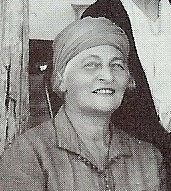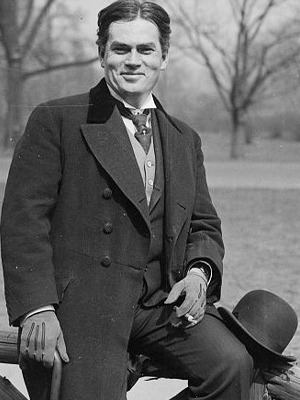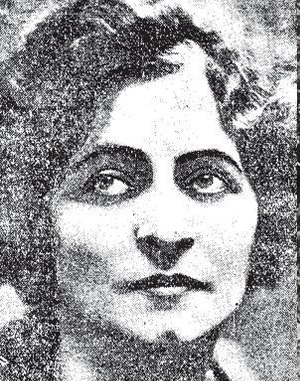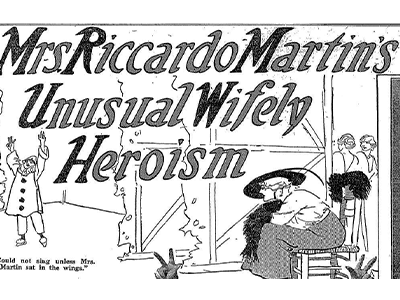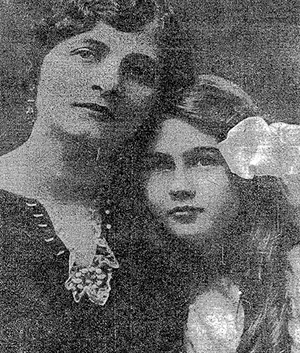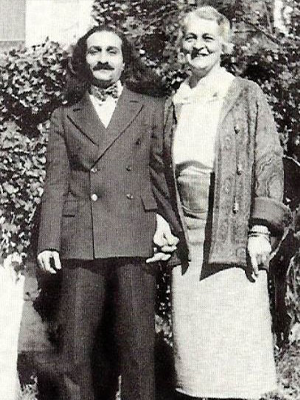Efreda Klamroth, 1876 – 1956
Though listed as a painter in the 1896 Indicateur guide to artists in Paris, Efreda Klamroth (her first name is sometimes spelled Elfrida or Elfrieda or Elfreda) was a renowned opera singer with the stage name Ruano Bogislav. Her New York Times obituary, published on February 8, 1956, chronicled her career and family history, describing her as a "romantic figure in the musical world [...] who was considered to have sacrificed her own career to aid her talented husband." That husband was Riccardo Martin, an operatic tenor known as the "American Caruso," who sang at the Metropolitan Opera from 1907 through 1915.
Her brother, Wilfried Klamroth, a baritone, had toured the United States and Europe with several opera companies before settling in New York and teaching at Columbia University, Teachers College, and the Institute of Musical Art. Klamroth followed her brother in studying music, but as a young woman, she was also quite interested in poetry and in painting. An 1894 review of minor New York art exhibitions published in The New York Times identifies her as a student of the painter William Merritt Chase who participated in a "creditable exhibition" held at the Sanchez & Co. gallery on West 23rd Street. Klamroth must have gone abroad shortly after this exhibition and likely spent her time in Paris studying both music and art while living at 4 rue de Chevreuse.
Klamroth and Martin married in New York in 1899. In addition to their fame on the stage, the couple was known for their active social life and lavish parties chronicled in New York's society pages. In 1912, The New York Tribune described an "Arabian Night's Masque" co-hosted by the Martins and Mr. and Mrs. Pliny Fisk, at which everyone was "masked and in Oriental costumes." The article paints a picture of the raucous scene, with dancing until 1 o'clock in the morning, when supper was served and followed up by more dancing. Town & Country magazine described the Martins' thés dansants in 1914 as events that "bring out all the stars in the afternoon and many women prominent in the social world." But the marriage was rocky.
The August 22, 1915 headline story in The Washington Post about Mrs. Martin's "unusual wifely heroism" laid bare the couple's trial separation and the dedication she had shown in putting aside her own career to fully support her husband. Riccardo's idiosyncratic demands and his reliance on his wife to dress him and supervise all aspects of his singing were described as "artistic temperament," while Klamroth's behavior was characterized as loving, stoic and self-sacrificing. The couple divorced in 1920 after two decades together, but remained committed to raising their daughter, Biji Martin, who went on to become a prominent actress, fashion director, and writer.
Usually described as "the former Mrs. Riccardo Martin" in the press, Klamroth resumed her singing career under the stage name of Ruano Bogislav following her divorce. Her concerts often included Slavic and Italian songs as well as works by Debussy, like "La Flute de Pan." Bogislav excelled at performing folk songs from various cultures, mostly Eastern European and Russian. A performance in Atlanta in 1922 dazzled, with The Atlanta Constitution raving about her voice and her ability to sing a wide range of songs in such diverse languages. She was considered "a woman of striking appearance, tall and dark" with "personal magnetism" that infused her contralto voice.
In Italy in the 1930s, Klamroth was introduced by British actor and dancer Quentin Tod to the Indian spiritual master, Meher Baba, whom she would follow for the rest of her life. Baba claimed that he was an Avatar, essentially a god in human form, and he attracted many followers when he began visiting the West in 1931. Celebrities and artists like Tallulah Bankhead, Boris Karloff, Mary Pickford, Douglas Fairbanks, Jr., and Klamroth flocked to him, embracing his teachings. Klamroth was one of a number of Western women who joined Meher Baba on a series of trips throughout India and British Ceylon (now Sri Lanka).
Klamroth died from a heart attack in New York on February 8, 1956.
Sources
- Bogislav, Ruano. "From a Nasik Notebook." The Awakener, vol. 16, no. 2, 1976, pp. 3-11.
- Bogislav, Ruano. "How I Met Baba." The Awakener, vol. 3, no. 3, Winter 1956, pp.1-6.
- Dooly, Louise. "Madame Bogislav Delights with Program of Folk Songs." The Atlanta Constitution, February 25, 1922, p.11. ProQuest Historical Newspapers.
- K.W. "Mrs. Riccardo Martin Sings at Princess Theatre Recital." New-York Tribune, February 28, 1919, p.11. ProQuest Historical Newspapers.
- Mephisto. "Mephisto's Musings." Musical America, vol. 22, no. 18, September 4, 1915, pp. 7-8. Google Books.
- "Mrs. Riccardo Martin's Unusual Wifely Heroism." The Washington Post, August 22, 1915, p.M6. ProQuest Historical Newspapers.
- "New York Society." New-York Tribune, March 20, 1912, p.6. ProQuest Historical Newspapers.
- "Riccardo Martin, Opera Singer, Dies." The New York Times, August 12, 1952, p. 19.
- "Ruano Bogislav, 81, Ex-Concert Singer." The New York Times, February 8, 1956, p.33.
- "Ruano Bogislav." Meher Baba's Life & Travels.
- Saerchinger, Cesar. "Riccardo Martin." International Who's Who in Music and Musical Gazetteer. New York: Current Literature Publishing Company, 1918, p.409.
- "Some Minor Exhibitions: Landscape and Figure Work by American Masters and Beginners." The New York Times, April 20, 1894, p.4.
- "The Week in Society: Mrs. Riccardo Martin the Hostess." Town & Country: New York, vol. 68, no. 3536, February 21, 1914, p. 28. ProQuest.
